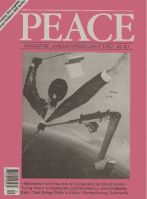
Peace Magazine Jan-Feb 1992, page 10. Some rights reserved.
Search for other articles by David Wurfel here
This is a time of celebration in Cambodia and also a time of foreboding
In October the four feuding factions finally signed a peace agreement and the U.N. Security Council offered to play a very major role in implementing it. A generation of excruciating pain, from bombardment by the Americans to slaughter by the Khmer Rouge (K.R.), may be coming to an end. But some of the most serious problems have yet to be overcome.
How did it all happen? Since the late 1970s internal Cambodian conflicts were fueled by Sino-Soviet rivalry, with the Vietnamese acting as the Soviet's ally. But when the Soviets decided to withdraw from South-East Asia-and then abandoned Communism-the international context was fundamentally changed. lacking Soviet economic and military support, Vietnamese troops pulled out of Cambodia in 1989, after ten years of occupation. For China Vietnam was no longer seen as a Soviet pawn, and by 1991 the Vietnamese leadership also began to look more favorably on China, even regarding it as a model for the preservation of party rule in the midst of economic liberalization. The rationale for American support of the Chinese and their Khmer Rouge clients also evaporated. With Sino-Vietnamese rapprochement Cambodian factions had new incentives to come to terms.
The mercurial Prince Sihanouk, now 70, was also key to the settlement. Though once regarded as a puppet of Beijing, he has reasserted his earlier role of neutral nationalist, emerging as the likely next chief of state, with the support of the once pro-Vietnamese premier of the Phnom Penh government, Hun Sen. Several members of Sihanouk's family were killed by the Khmer Rouge, so he can easily join forces with Hun Sen to prevent their return to power.
However, the Khmer Rouge have been given a significant voice in the transitional regime which follows the ceasefire, thus raising fears around the world that under conditions of renewed instability they might in fact take over all power forcefully (they could hardly win an election.) While such a possibility cannot be ruled out, it does not now seem likely. Though they have been regarded as the most effective Cambodian fighting force, they probably have not had the support of more than 15% of the population and even some of that is the consequence of threats and coercion. Furthermore, with the departure of the Vietnamese, the K.R.'s main political appeal, their anti-Vietnamese nationalism, is undermined. If, as planned, the U.N. forces (not yet including Canadians) are strong enough to disarm and demobilize 70% of all armed units in Cambodia, the K.R. "edge" will be lost. In the meantime the Communist regime in Phnom Penh has renounced Marxism-Leninism and has embraced market-oriented economic reforms, including private ownership of land, thus facilitating alliance with Sihanouk and increasing their popular appeal.
Blocking a K.R. power-grab would clearly depend to a considerable degree on the effectiveness of an unprecedented U.N. presence, the largest, the most expensive (made possible by heavy yen contributions), and the most intrusive in the U.N.'s history. The U.N. Transitional Authority for Cambodia (UNTAC), designed to act regardless of the debilitating suspicions each Khmer faction has of the other, will practically have the power of a sovereign state until free elections are held. But it is uncertain whether thousands of soldiers and bureaucrats from around the world who know almost nothing about Cambodian language, history, culture and institutions can step in and govern this nation of seven to eight million. In this ambitious enterprise there must be many quick learners. One might hope at least the peacekeeping function will be carried out. Day to day civilian administration will probably have to be limited to U.N. supervision of the existing state structure, centred on Phnom Penh, that covers most of the country.
In any case, the prospects for peace and free elections will depend largely on the rebuilding of the economy. Pledges of aid from Western governments are forthcoming now that the U.S.-led embargo has been lifted. NGOs with CIDA support so far constitute the Canadian presence. But the problems are massive-from bomb blasted roadways to land mines in the rice fields-and present pledges may not be enough.
If free elections are held, Prince Sihanouk, once the nation's hereditary ruler, but also a masterful campaigner, is likely to be the main beneficiary. For many Khmer he symbolizes the peace and prosperity of the early '60s. He cannot, of course, bring back that era, but he may be able to provide unifying leadership. The deep distrust among competing factions will complicate the task of building stable institutions.
But some Cambodian factions are exhausted by the struggle and by the disappearance of foreign backers. There is a fair chance that they will cooperate and that Cambodia will soon be free from armed conflict. They can then refocus their energies on the economy and on continued reconstruction. Adequate and welt-distributed foreign assistance, and skillful tailoring of the UNTAC role, may reinvigorate a cultural tradition of great beauty. It is high time that the international community contributed to peace, not war, in that once happy land. U David Wurfel teaches political science at Windsor University.

Peace Magazine Jan-Feb 1992, page 10. Some rights reserved.
Search for other articles by David Wurfel here